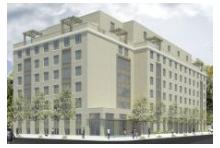Edwin’s Place HDFC
A Mix of Affordable Rental Housing for Low-Income Working Families and Permanent Supportive Rental Housing for Special Needs Homeless Families, Single Adults and Veterans
The Goal of Edwin’s Place
The goal of Edwin’s Place is to meet the immediate and long term housing needs of low-income working families and single adults from the underserved neighborhood of Brownsville/East New York, as well as the housing needs of special needs homeless families and single adult New Yorkers living with mental health disorders, and chronic histories of substance abuse who seek affordable, permanent supportive housing with onsite daily supportive services. The target population includes formerly homeless Vets.
Edwin’s Place Mission Statement
* To provide access to clean, safe, permanent supportive housing in a totally drug-free environment for formerly homeless single adults regardless of their race, socio-economic status, or sexual orientation.
* To provide clean, safe, affordable rental housing to single adults and families.
* To ensure that each special-need tenant remains connected to treatment and obtains the best possible health outcomes, as needed.
* To provide direct and indirect services in a supportive environment.
•To empower our tenants physically, emotionally, socially, and spiritually.
Additionally, Edwin’s Place seeks to facilitate independence, dignity and well-being through a complement of safe, affordable housing and day-to-day services provided to all tenants. All tenants MUST be capable of independent living and may not require 24 hour round-the-clock, on-site medical intervention.
The building has a 24/7 attended lobby, a state-of-the-art camera system, and exterior lighting that enhances community safety. The building is designed with a multipurpose room available for community events and meetings. There are many Green features including green roof, energy star appliances, water conserving fixtures, and other sustainable design elements.
Low-Income Working Single Adults & Families
Critical to the success of AAPCI’s housing management model is our commitment to inclusive, mixed-income communities. Rather than being marginalized in quasi-institutional settings, our formerly homeless tenants live alongside a diverse group of low-income professionals. In addition to making it possible for street homeless individuals to renew their lives; the affordability, security, and prime location of AAPCI’s housing enables our tenants for whom city life would not otherwise be financially feasible; to contribute to the unique character of the Big Apple. Some are young people newly embarking on an independent life, while others are winding down their careers or cutting down on expenses after retirement.
Mental Health & Substance Abuse
The movement in the 1970s to deinstitutionalize psychiatric patients had the unintended consequence of leaving scores of individuals with mental illnesses without access to appropriate care or supports. As a result, many became homeless.
Of the estimated 744,000 people who are homeless on any given night across the United States, nearly half of them have a serious mental illness, such as clinical depression, schizophrenia, bipolar disorders, personality disorders, and substance abuse.
Most of the mentally ill homeless go untreated, and unable to work, live a hand-to-mouth existence out on the streets. They also frequently cycle in and out of medical and psychiatric hospitals, drug rehabilitation programs, and prisons and jails, at enormous personal and public costs.
Edwin’s Place offers a life-enriching alternative to both institutionalization and life on the streets. Tenants are offered the opportunity to manage their illness while living independently in the housing, with the support of on-site case managers and links to appropriate care.
Veterans
AAPCI assists several special needs segments of the chronically homeless population in New York City, and regrettably, these include a significant number of military veterans. We serve veterans in all program areas, from transitional to permanent supportive housing.
Unit Breakdown
* 46 units are family units – one-, two-, and three-bedroom apartments. 1 unit is a studio apartment. 55 studios plus 23 family apartments are aside for formerly homeless persons or families; 46 family apartments plus 1 studio are set aside for low-income community residents with incomes below 60% of the area median income. 50% of the low income apartments are set aside for Community Board 16 (Ocean Hill/Brownsville) residents.
